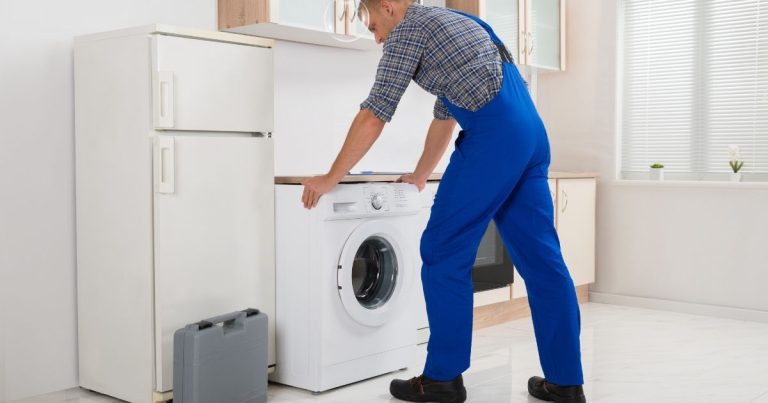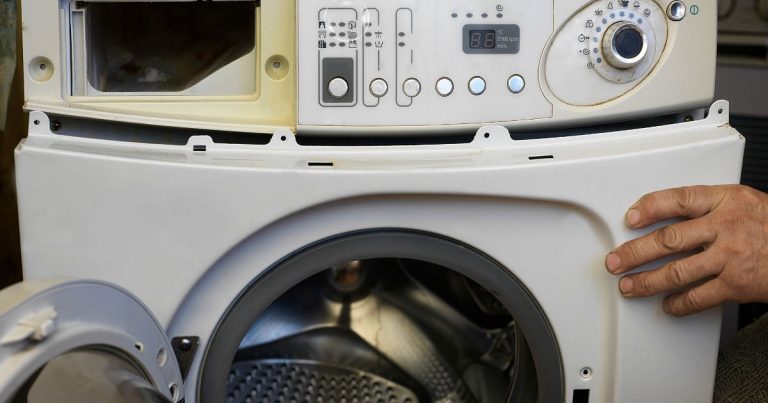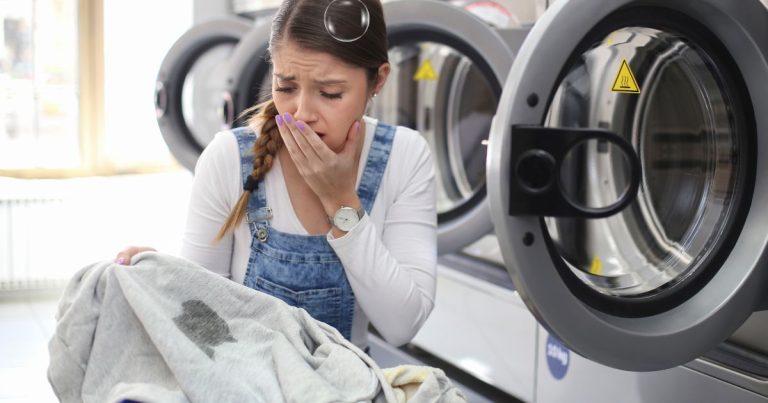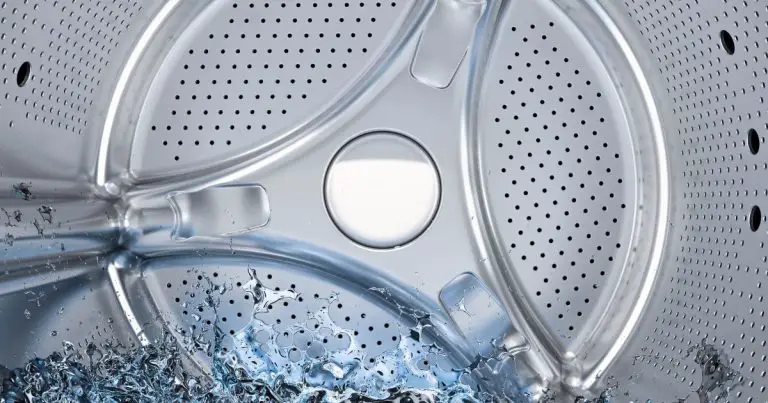12 Effective Ways to Fix a (GE Washer Not Spinning Clothes Dry)
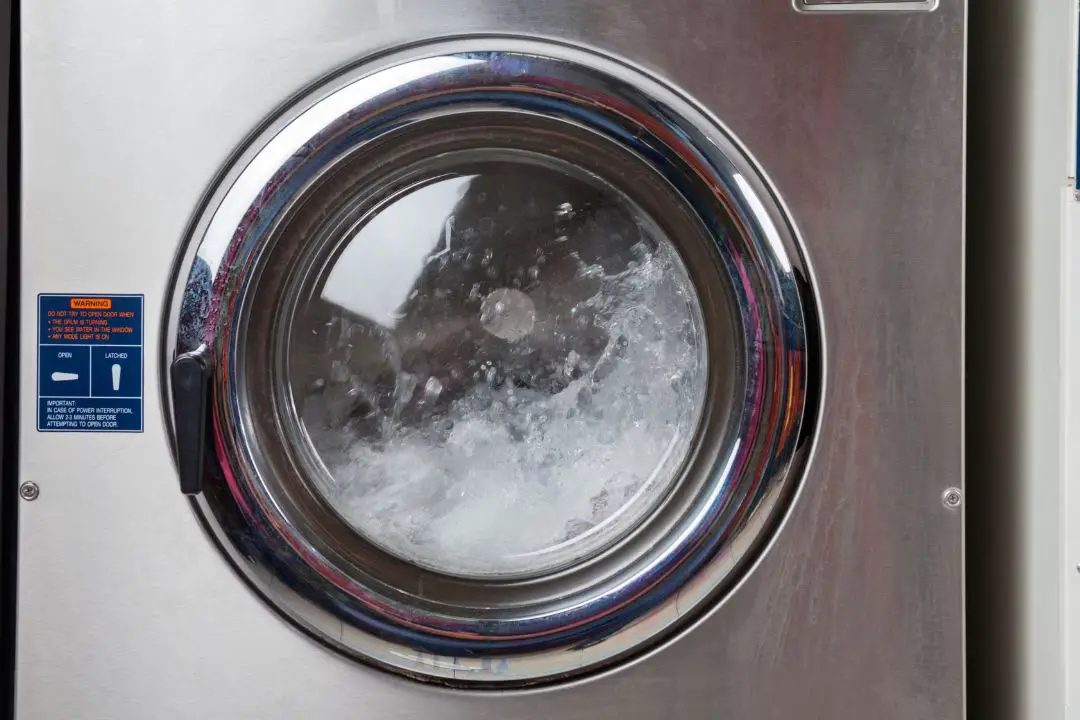
A GE washer not spinning clothes dry can be a frustrating experience for anyone. However, before calling a repairman or purchasing a new washer, there are several things that can be done to fix the problem.
In this article, we will explore 12 ways to fix a GE washer not spinning clothes dry.
First, it is important to understand why the washer is not spinning. There are several reasons why this might be happening, including a broken belt, a malfunctioning lid switch, or a faulty motor.
Once the cause of the problem has been identified, the appropriate solution can be applied.
Some of the solutions that will be discussed in this article include checking the lid switch, inspecting the drive belt, cleaning the drain pump filter, and replacing the motor.
By following these steps, it is possible to fix a GE washer not spinning clothes dry without having to spend a lot of money on repairs or a new washer.
How To Fix GE Washer Not Spinning Clothes Dry?
| # | Solution | Description |
|---|---|---|
| 1 | Adjust cycle setting | Make sure the cycle setting is appropriate for the load you are washing |
| 2 | Check spin speed | Ensure that the spin speed is sufficient to spin clothes dry |
| 3 | Distribute load evenly | Make sure the load is evenly distributed in the washer |
| 4 | Check lid switch | Test the lid switch for continuity and replace if defective |
| 5 | Inspect motor | Check the motor for any issues such as worn out brushes or a faulty capacitor |
| 6 | Clear drain hose | Remove any clogs or debris from the drain hose |
| 7 | Check pump | Inspect the pump for any damage or blockages |
| 8 | Clean filter | Clean the filter to remove any debris |
| 9 | Check belt | Inspect the belt for any signs of wear or damage |
| 10 | Replace clutch | Replace the clutch if it is worn out or damaged |
| 11 | Check suspension springs | Inspect the suspension springs for any damage or wear |
| 12 | Loose Power Connection | Ensure that the power cord is securely plugged into the outlet and the washer. Check the power cord for any signs of damage or wear and replace it if necessary. Check the circuit breaker or fuse box to ensure that the circuit is not overloaded or tripped. |
1. Check the Power Supply:

If your GE washer is not spinning clothes dry, the first thing you need to check is the power supply.
Without adequate power, your washer won’t be able to function properly. Here are a few things you can check:
Check the Outlet.
Make sure the outlet your washer is plugged into is working properly. You can do this by plugging in another appliance or device and seeing if it works.
If the outlet is not working, you may need to reset the circuit breaker or call an electrician to fix the issue.
Check the Power Cord.
Inspect the power cord for any damage or wear and tear. If the cord is damaged, it may need to be replaced.
Additionally, make sure the cord is plugged in securely to both the outlet and the washer.
If the cord is loose, your washer may not be getting enough power to function properly.
By checking the power supply, you can quickly identify and fix any issues that may be preventing your GE washer from spinning clothes dry.
2. Inspect the Lid Switch:
If the GE washer is not spinning clothes dry, the lid switch may be the culprit. The lid switch is a safety device that prevents the washer from spinning if the lid is open.
If the switch is malfunctioning, the washer will not spin. Here are some steps to inspect the lid switch:
Check the Lid Switch Connections.
First, unplug the washer and locate the lid switch. It is usually located near the door frame.
Check the connections to make sure they are not loose or corroded. If the connections are loose, tighten them. If they are corroded, clean them with a wire brush or sandpaper.
Replace the Lid Switch.
If the connections are fine, the lid switch may need to be replaced. To replace the lid switch, first, unplug the washer and remove the control panel.
Remove the clips that hold the switch in place and disconnect the wires. Install the new switch and reattach the wires and clips. Reinstall the control panel and plug the washer back in.
Inspecting the lid switch is just one of the many ways to fix a GE washer that is not spinning clothes dry. If the problem persists, it may be necessary to call a professional for further assistance.
3. Examine the Drive Belt:
One of the most common reasons for a GE washer not spinning clothes dry is a worn or broken drive belt.
The drive belt is responsible for turning the drum, and if it’s damaged, the washer won’t be able to spin. Here’s what to do:
Check the Belt for Wear and Tear.
The first step is to visually inspect the drive belt for any signs of wear and tear. Look for cracks, fraying, or other damage.
If you see any of these signs, it’s time to replace the belt. You can purchase a replacement belt online or at your local appliance store.
Adjust or Replace the Drive Belt.
If the belt looks okay, the next step is to check its tension. The belt should be tight enough to turn the drum, but not so tight that it puts undue stress on the motor.
To adjust the tension, loosen the bolts that hold the motor in place and move it slightly until the belt is tight enough. Then, tighten the bolts again.
If the belt tension is correct but the washer still isn’t spinning, it’s possible that the belt has stretched over time and needs to be replaced.
Refer to your washer’s manual for instructions on how to replace the drive belt.
4. Inspect the Motor Coupling:
One of the most common reasons a GE washer may not spin clothes dry is a malfunctioning motor coupling.
The motor coupling connects the washer’s motor to the transmission. When it fails, the washer will not spin. Here are some steps to inspect the motor coupling:
Check the Motor Coupling for Damage.
First, unplug the washer and remove the cabinet. Locate the motor coupling, which is usually located near the bottom of the washer.
Inspect the coupling for any signs of wear or damage, such as cracks or missing pieces. If the coupling is damaged, it will need to be replaced.
Replace the Motor Coupling.
If the motor coupling is damaged, it will need to be replaced. To do this, first, unplug the washer and remove the cabinet.
Locate the motor coupling and remove it from the motor and transmission. Install the new coupling onto the motor and transmission, making sure it is properly aligned.
Reassemble the washer and test it to ensure it is spinning properly.
Inspecting the motor coupling is an important step in fixing a GE washer that is not spinning clothes dry.
By checking the coupling for damage and replacing it if necessary, homeowners can save money on costly repairs and keep their washer running smoothly.
5. Check the Transmission:

One of the most common reasons why a GE washer may not be spinning clothes dry is due to transmission issues. Here are a few steps to check the transmission:
Inspect the Transmission for Damage.
The first step is to inspect the transmission for any signs of damage. Start by unplugging the washer and removing the front panel.
Look for any cracks or signs of wear and tear on the transmission. If you notice any damage, the transmission will need to be replaced.
Replace the Transmission.
If the transmission is damaged, it will need to be replaced. This is a complex repair that should be done by a professional.
A transmission replacement typically involves removing the motor, pump, and other components from the washer.
The new transmission is then installed and all of the components are reassembled.
Replacing the transmission can be expensive, so it’s important to weigh the cost of the repair against the age and condition of the washer.
If the washer is old and has other issues, it may be more cost-effective to replace the entire unit.
Overall, checking the transmission is an important step in fixing a GE washer that’s not spinning clothes dry. By inspecting the transmission for damage and replacing it if necessary, you can get your washer back up and running smoothly.
6. Inspect the Clutch Assembly:
One of the common reasons why a GE washer may stop spinning clothes dry is due to a faulty clutch assembly.
The clutch assembly is responsible for engaging the transmission, which in turn drives the washer’s tub to spin.
If the clutch assembly is not functioning properly, the tub will not spin, and clothes will remain wet after the wash cycle.
Check the Clutch for Wear and Tear.
The first step in inspecting the clutch assembly is to check for any signs of wear and tear.
Look for any cracks, chips, or other damage to the clutch assembly. If there is visible damage, the clutch assembly will need to be replaced. Additionally, check the clutch lining for any signs of wear.
The clutch lining is a circular piece of material that sits between the clutch assembly and the transmission.
Over time, the clutch lining can wear down, causing the clutch to slip and fail to engage the transmission. If the clutch lining is worn, it will need to be replaced.
Replace the Clutch Assembly.
If the clutch assembly needs to be replaced, it is recommended to seek the assistance of a professional.
Replacing the clutch assembly involves disassembling the washer’s transmission, which can be a complicated and time-consuming process.
A professional technician will have the necessary tools and expertise to safely and efficiently replace the clutch assembly.
If you are confident in your DIY skills, you can attempt to replace the clutch assembly yourself.
However, be sure to follow the manufacturer’s instructions carefully and take all necessary safety precautions.
7. Examine the Suspension Springs:
When a GE washer is not spinning clothes dry, one of the possible culprits is a problem with the suspension springs.
These springs help to absorb the vibrations of the washer during the spin cycle, and if they are damaged or worn out, they may not be able to perform this function properly. Here are a few steps to examine the suspension springs:
Check the Springs for Damage.
The first step in examining the suspension springs is to visually inspect them for any signs of damage.
Look for cracks, breaks, or other signs of wear and tear. If you see any damage, it is likely that the springs will need to be replaced.
It is also a good idea to check the mounting brackets for the springs to make sure they are securely attached to the washer frame.
Replace the Suspension Springs.
If the suspension springs are damaged or worn out, they will need to be replaced. This can be a challenging task, so it may be best to hire a professional to do the job.
However, if you are comfortable working with appliances and have the necessary tools, you can replace the springs yourself.
Make sure to purchase the correct replacement parts for your specific GE washer model.
Overall, examining the suspension springs is an important step in fixing a GE washer that is not spinning clothes dry.
By checking for damage and replacing worn out springs, you can help ensure that your washer is functioning properly and avoid the need for costly repairs down the line.
8. Inspect the Drain Pump:

When a GE washer is not spinning clothes dry, it could be due to a clogged or faulty drain pump. Inspecting the drain pump is a crucial step in troubleshooting the issue.
Check the Drain Pump for Clogs.
The drain pump is responsible for removing water from the washer during the spin cycle.
Over time, debris such as lint, coins, and other small objects can accumulate in the pump, causing it to clog. To check for clogs, follow these steps:
- Unplug the washer from the power source.
- Locate the drain pump at the bottom of the washer.
- Remove any visible debris or objects from the pump.
- Use a flashlight to inspect the pump for any remaining clogs.
- If there are still clogs, use a small brush or toothbrush to remove them.
Replace the Drain Pump.
If the drain pump is damaged or faulty, it may need to be replaced. To replace the pump, follow these steps:
- Unplug the washer from the power source.
- Locate the drain pump at the bottom of the washer.
- Disconnect the hoses and wires connected to the pump.
- Remove the pump from the washer.
- Install the new pump and reconnect the hoses and wires.
Inspecting the drain pump is an important step in fixing a GE washer that is not spinning clothes dry. By checking for clogs and replacing the pump if necessary, you can help ensure that your washer is working properly and efficiently.
9. Check the Water Level Switch:
One of the reasons why a GE washer may not be spinning clothes dry is due to an issue with the water level switch.
This switch is responsible for detecting the water level in the washer and signaling the control board to start the spin cycle.
If the switch is faulty or not working correctly, it can prevent the washer from spinning the clothes dry.
Inspect the Water Level Switch Connections.
The first step in checking the water level switch is to inspect the connections. Start by unplugging the washer and locating the water level switch, which is usually located near the control panel.
Check the wires and connections to ensure they are secure and free from any damage or corrosion. If any issues are found, replace the damaged parts and reconnect the wires.
Replace the Water Level Switch.
If the connections are fine, but the water level switch is still not working correctly, it may be time to replace the switch.
To do this, first, order a replacement switch from a GE dealer or an authorized parts distributor.
Once you have the new switch, unplug the washer and remove the control panel to access the switch.
Follow the manufacturer’s instructions to remove and replace the switch, making sure to reconnect all wires and connections correctly.
Checking and fixing the water level switch can be a simple and effective way to get your GE washer spinning clothes dry again.
If you are unsure about any of the steps or if the issue persists, it may be best to contact a professional technician for further assistance.
10. Inspect the Timer:
When a GE washer is not spinning clothes dry, the timer may be the culprit. The timer controls the various cycles of the washer, and if it is not functioning properly, it can prevent the washer from spinning. Here are some steps to take when inspecting the timer:
Check the Timer for Damage.
The first step in inspecting the timer is to check for any visible damage. Look for any cracks or chips in the timer housing or any loose wires. If you find any damage, the timer will need to be replaced.
Next, check the timer contacts for wear or damage. The contacts are the small metal pieces that make contact with the timer motor. If they are worn or damaged, they will need to be replaced.
Replace the Timer.
If you have determined that the timer is faulty, it will need to be replaced. Before replacing the timer, be sure to disconnect the power to the washer.
To replace the timer, remove the control panel from the washer. This may involve removing screws or clips that hold the panel in place.
Once the panel is removed, locate the timer and disconnect any wires that are connected to it.
Remove the old timer and install the new one in its place. Reconnect any wires that were disconnected and replace the control panel.
Finally, restore power to the washer and test it to ensure that it is functioning properly.
Inspecting the timer is just one of the many steps that can be taken to fix a GE washer that is not spinning clothes dry. By following these steps, you can identify and fix the problem quickly and easily.
11. Examine the Control Board:
If none of the previous solutions work, it may be necessary to examine the control board. This is the brain of the machine, and if it’s not functioning properly, the washer won’t spin.
Check the Control Board for Damage.
The first thing to do is to check for any obvious signs of damage. Look for any visible cracks, burns, or corrosion on the control board. If you see any of these signs, the control board is likely the culprit and will need to be replaced.
You can also use a multimeter to test the control board for continuity. This will help you determine if any of the components are faulty.
If you’re not comfortable doing this yourself, it’s best to call a professional to avoid causing further damage to the machine.
Replace the Control Board.
If you’ve determined that the control board is the problem, it will need to be replaced.
You can order a replacement control board from the manufacturer or a third-party supplier. Make sure to get the correct part number for your specific model of GE washer.
Replacing the control board can be a bit tricky, so if you’re not comfortable doing it yourself, it’s best to call a professional. They will have the expertise and tools necessary to replace the control board quickly and safely.
12. Wrong Cycle Setting:
One common cause is a wrong cycle setting. If the cycle setting is incorrect, the washer may not spin clothes dry.
For example, if you select a delicate cycle, the washer will not spin clothes as vigorously as it would on a regular cycle, which could result in damp clothes.
To fix this issue, you should check the cycle setting and make sure it is appropriate for the load you are washing.
If you are unsure which cycle setting to use, refer to the washer’s manual or contact the manufacturer for assistance.
Additionally, you may want to check the washer’s spin speed setting, as a lower spin speed may not be sufficient to spin clothes dry.
By adjusting the cycle and spin speed settings, you can ensure that your GE washer spins clothes dry and leaves them ready to be dried or worn.
How to Reset A GE Washer That’s Not Spinning Clothes Dry?

To reset your GE washer that’s not spinning clothes dry, follow these steps:
- Unplug the washer: First, unplug your GE washer from the electrical outlet. This will ensure that the machine is completely disconnected from the power source.
- Wait for 2 minutes: Wait for about 120 seconds (2 minutes) to allow the washer to cool down and reset itself. This will also give enough time for the internal parts to reset and the electronic control board to clear any error codes.
- Turn off circuit breaker or timer knob: If your GE washer model does not have a power button, alternatively, you can shut off its circuit breaker or turn off the timer knob.
- Restore power: After 2 minutes, restore the power by plugging the washer back into the electrical outlet or turning on the circuit breaker or timer knob.
- Select spin cycle: Select the appropriate spin cycle for the load you are washing. Make sure the spin speed is sufficient to spin clothes dry.
- Check the load: Make sure the load is evenly distributed in the washer. If the load is too heavy or unbalanced, the washer may not spin clothes dry.
- Check the drain hose: Check the drain hose for any clogs or debris. If the drain hose is clogged, water may not be able to drain properly, which can cause the washer to stop spinning.
- Check the lid switch: Test the lid switch for continuity and replace if defective. A faulty lid switch can prevent the washer from spinning clothes dry.
- Check the motor: Inspect the motor for any issues such as worn out brushes or a faulty capacitor. If the motor is defective, it may need to be replaced.
FAQs:
Why is my GE washer not spinning clothes dry?
There could be several reasons why your GE washer is not spinning clothes dry, including a wrong cycle setting, a defective lid switch, a malfunctioning motor, or a clogged drain hose.
How can I fix a GE washer that is not spinning clothes dry?
If your GE washer is not spinning clothes dry, you can try adjusting the cycle setting, checking the spin speed setting, and making sure the load is evenly distributed. You can also check the lid switch, motor, and drain hose for any issues.
Can a clogged drain hose cause my GE washer to not spin clothes dry?
Yes, a clogged drain hose can prevent your GE washer from spinning clothes dry. If the drain hose is clogged, water may not be able to drain properly, which can cause the washer to stop spinning.
How can I check the lid switch on my GE washer?
To check the lid switch on your GE washer, you can open the lid and look for a small plastic or metal piece on the lid that corresponds to a switch on the washer. You can use a multimeter to test the switch for continuity.
Should I contact a professional if my GE washer is not spinning clothes dry?
If you are unable to fix your GE washer by adjusting the cycle setting, spin speed, and load distribution, or if you suspect a more serious issue such as a malfunctioning motor, it is recommended to contact a professional for assistance.

